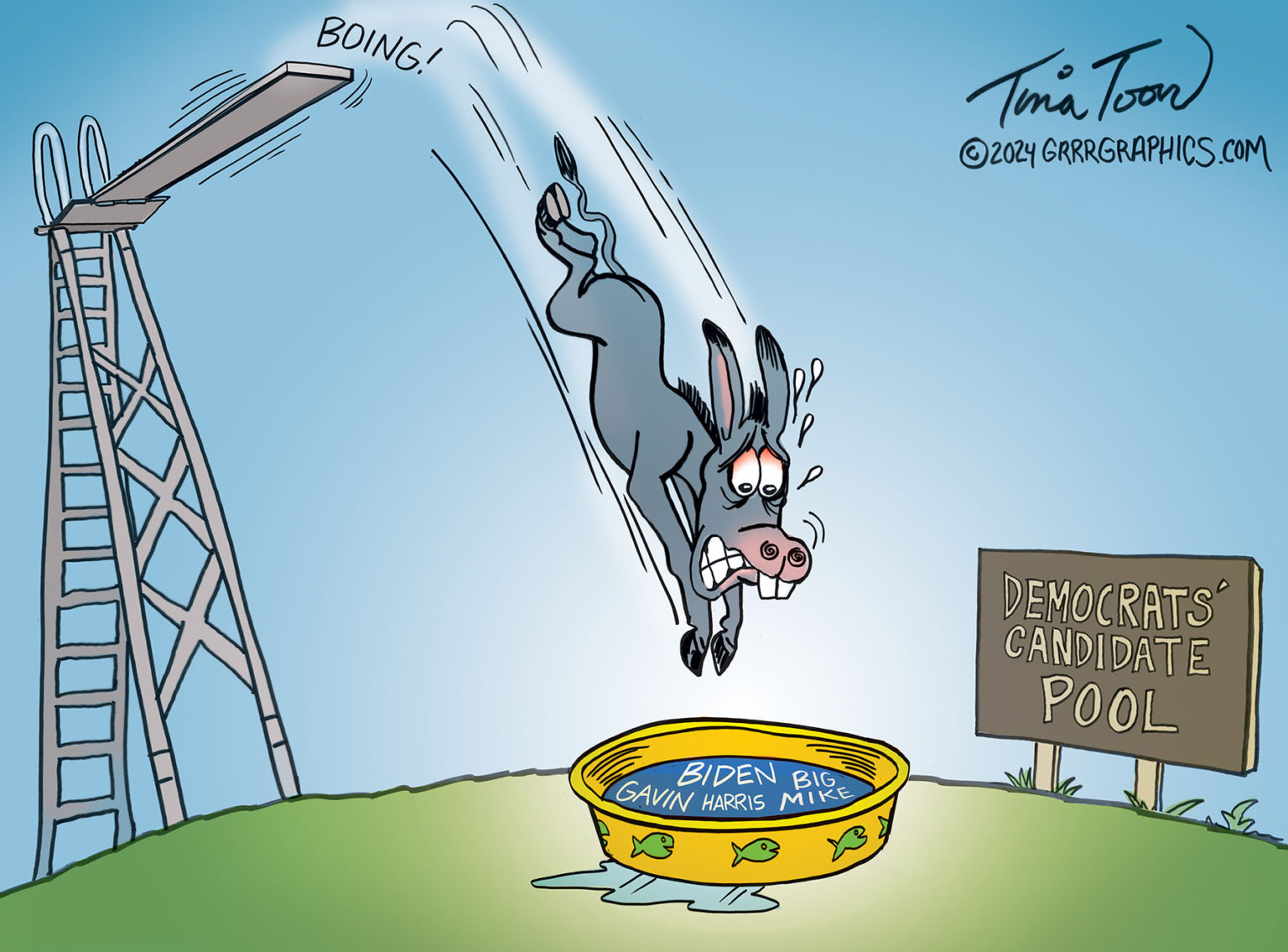The Biden regime's gaslighting about the economy is just nauseating.
People
Circles
Posts
‘A LOT OF LIES, GASLIGHTING’: Biden reportedly being kept ‘in a bubble’
https://www.brighteon.com/589acae3-bb8b-4b1e-993f-d781689bf5b1

Rep. Mark Alford, R-Mo., says 'it's clear' the American people want Donald Trump back in the White House, and puts the border crisis onus on President Biden.Follow NewsClips channel at Brighteon.com for more updatesSubscribe to Brighteon newsletter to get the latest news and more featured videos:https://support.brighteon.com/Subscribe.html
www.brighteon.com
DEMOCRATS TAKE A DIVE INTO A SHALLOW POOL
Tina Toon Cartoon published 02/24/2024
The Democrats are diving toward disaster and they know it. They are committed and can’t turn back. Joe Biden is their candidate and he has dementia. They can pretend that Joe is alert and on the case, but Americans can see through such gaslighting. Joe’s far-left policies are a disaster. Joe’s poll numbers are a disaster. Joe is a disaster.
There aren’t many candidates out there who can replace Biden. The candidate pool is small—there are no alternatives who can offer Trump a challenge. Sure, they all seem to want Gavin Newsom. Jake Tapper slobbered all over Gavin in a recent interview. Newsom is like Biden, only he can tell lies clearer and faster. Gavin ruined California so he might be a good fit since the Democrats seem bent on ruining America.
There are still people who think Michelle Obama will shoulder her way in and take the convention’s nomination. ‘Big Mike’ represents eight more years for Barack. We hope she does run—it will make for some fun cartoons.
Last and least is Kamala Harris, who is universally hated even by her own staff—and the turnover has been amazing. Her staff doesn’t like her. Nobody likes her. Nobody will vote for her. Nobody wants to listen to her as she chuckles out her strange three word cadences and nasal whine.
Yes, the pool is very shallow, but the Democrats have no choice but to dive in.
— The GrrrTeam
Videos
The US government needs to borrow another $2 trillion (or more) in 2024, but has just announced they will be buying their own debt back in 2024. What’s the real story here?
In this episode of Finance University Pual and I discuss the recent Honey Badger Gathering, as well as the extreme gaslighting by the US Treasury Department which is planning to buy back(!) Treasuries in order to “reduce volatility in their cash balances.”
Check out PeakFinancialInvesting.com today!
Order THE CRASH COURSE here:
https://www.barnesandnoble.com/w/the-...
Wanna buy me a coffee? https://www.buymeacoffee.com/PeakPros...
Join the #1 resilience community today!
https://peakprosperity.com/membership/
ALSO FOLLOW US HERE:
Twitter: @Chris_martenson
https://rumble.com/c/PeakProsperity
https://odysee.com/@Chris_Martenson:2
FINANCIAL DISCLAIMER. PEAK PROSPERITY, LLC, AND PEAK FINANCIAL INVESTING ARE NOT ENGAGED IN RENDERING LEGAL, TAX, OR FINANCIAL ADVICE OR SERVICES VIA THIS WEBSITE. NEITHER PEAK PROSPERITY, LLC NOT PEAK FINANCIAL INVESTING ARE FINANCIAL PLANNERS, BROKERS, OR TAX ADVISORS. Their websites are intended only to assist you in your financial education. Your personal financial situation is unique, and any information and advice obtained through this website may not be appropriate for your situation. Accordingly, before making any final decisions or implementing any financial strategy, you should consider obtaining additional information and advice from your accountant or other financial advisers who are fully aware of your individual circumstances.
Elias showed typical milestones and growth until his 4 month “Wellness” visit. Despite Elias having a cold, the doctor gave him 4 vaccines that day. At 4 a.m. following the visit, Elias began having seizures.
After years of seizures, medical gaslighting, and his parents searching for answers, Elias unfortunately passed away at 4 years old after a 75 minute seizure.
Elias’s photograph is now placed in-memoriam at the front of the #CHDBus, where CHD will be collecting vaccine death and injury stories from across the country.
Watch the full story on #CHDTV ?
https://live.childrenshealthdefense.org/chd-tv/shows/good-morning-chd/dr-mercola-responds-to-chase-debanking--more/
Welcome to The Daily Wrap Up, a concise show dedicated to bringing you the most relevant independent news, as we see it, from the last 24 hours.
All Video Source Links Can Be Found Here At The Last American Vagabond: https://www.thelastamericanvagabond.com/gaslighting-child-trafficking
Want to send a check to support TLAV, or just words of encouragement?
Use our new P.O. box:
Ryan Cristian
1113 Murfreesboro Rd. Ste 106-146
Franklin, Tn 37064
Get TLAV Apparel:
https://truthclothing.io/collections/tlav
https://tlavfreespeech.itemorder.com/shop/home/
Support TLAV through Autonomy:
Join Autonomy:
https://www.universityofreason.com/a/29887/QZmKjVCA
Ryan Cristián’s Objectivity Course:
https://marketplace.autonomyagora.com/objective-research
Richard Grove’s Course:
https://www.universityofreason.com/a/2147526145/QZmKjVCA
Like What You See? Help Us Stay People Funded:
https://tlavagabond.substack.com/
https://www.thelastamericanvagabond.com/donations/donation-form/
https://www.subscribestar.com/the-last-american-vagabond
https://cash.app/$TLAVagabond
https://www.buymeacoffee.com/tlavagabond
Bitcoin Donations: 3HybuDuvH4x5uJHemgc7EW4ms2nz3F8Gah
Ethereum Donations: 0x5e68B8984d9D8167dAf890588a7037Ae6Cc87d4b
Litecoin Donations: MX3T2kYvzfD4mNS4VNSyXFgY4abhUJC5ff
Bitcoin Cash Donations: qqsef23980qu5nlk2dj7s7ezwedl4fmy2gl2mxp9dp
Support The Last American Vagabond by Subscribing here:
http://www.feedblitz.com/f/?Sub=906867
The Last American Vagabond Links:
Sovern: https://sovren.media/u/tlavagabond/
Rumble: https://rumble.com/user/TheLastAmericanVagabond
Odysee: https://odysee.com/@TLAVagabond:5
Rokfin: https://www.rokfin.com/TLAVagabond
Minds: https://www.minds.com/TLAVagabond
Bitchute: https://www.bitchute.com/channel/24yVcta8zEjY/
Telegram: https://t.me/TLAVagabond
VK: https://vk.com/id504366611
Twitter: https://twitter.com/TLAVagabond
Instagram: https://www.instagram.com/the_last_american_vagabond/
TikTok: https://www.tiktok.com/@thelastamericanvagabond
Getter: https://gettr.com/user/tlavagabond
TruthSocial: https://truthsocial.com/@TLAVagabond
Locals: https://thelastamericanvagabond.locals.com/
Facebook: https://www.facebook.com/Vagabond-Censored-103475109010293/
Memo: https://memo.cash/profile/1Np4Z2d25RSsQi99gKhf2cd5CAwN57jk13
MeWe: https://mewe.com/profile/5bcfb5d2a5f4e5420d7d5a2f
#TLAVPirateStreams #TheDailyWrapUp #TheLastAmericanVagabond
"Copyright Disclaimer Under Section 107 of the Copyright Act 1976, allowance is made for "fair use" for purposes such as criticism, comment, news reporting, teaching, scholarship, and research. Fair use is a use permitted by copyright statute that might otherwise be infringing. Non-profit, educational or personal use tips the balance in favor of fair use.”
People
Circles
Videos
The US government needs to borrow another $2 trillion (or more) in 2024, but has just announced they will be buying their own debt back in 2024. What’s the real story here?
In this episode of Finance University Pual and I discuss the recent Honey Badger Gathering, as well as the extreme gaslighting by the US Treasury Department which is planning to buy back(!) Treasuries in order to “reduce volatility in their cash balances.”
Check out PeakFinancialInvesting.com today!
Order THE CRASH COURSE here:
https://www.barnesandnoble.com/w/the-...
Wanna buy me a coffee? https://www.buymeacoffee.com/PeakPros...
Join the #1 resilience community today!
https://peakprosperity.com/membership/
ALSO FOLLOW US HERE:
Twitter: @Chris_martenson
https://rumble.com/c/PeakProsperity
https://odysee.com/@Chris_Martenson:2
FINANCIAL DISCLAIMER. PEAK PROSPERITY, LLC, AND PEAK FINANCIAL INVESTING ARE NOT ENGAGED IN RENDERING LEGAL, TAX, OR FINANCIAL ADVICE OR SERVICES VIA THIS WEBSITE. NEITHER PEAK PROSPERITY, LLC NOT PEAK FINANCIAL INVESTING ARE FINANCIAL PLANNERS, BROKERS, OR TAX ADVISORS. Their websites are intended only to assist you in your financial education. Your personal financial situation is unique, and any information and advice obtained through this website may not be appropriate for your situation. Accordingly, before making any final decisions or implementing any financial strategy, you should consider obtaining additional information and advice from your accountant or other financial advisers who are fully aware of your individual circumstances.
Elias showed typical milestones and growth until his 4 month “Wellness” visit. Despite Elias having a cold, the doctor gave him 4 vaccines that day. At 4 a.m. following the visit, Elias began having seizures.
After years of seizures, medical gaslighting, and his parents searching for answers, Elias unfortunately passed away at 4 years old after a 75 minute seizure.
Elias’s photograph is now placed in-memoriam at the front of the #CHDBus, where CHD will be collecting vaccine death and injury stories from across the country.
Watch the full story on #CHDTV ?
https://live.childrenshealthdefense.org/chd-tv/shows/good-morning-chd/dr-mercola-responds-to-chase-debanking--more/
Welcome to The Daily Wrap Up, a concise show dedicated to bringing you the most relevant independent news, as we see it, from the last 24 hours.
All Video Source Links Can Be Found Here At The Last American Vagabond: https://www.thelastamericanvagabond.com/gaslighting-child-trafficking
Want to send a check to support TLAV, or just words of encouragement?
Use our new P.O. box:
Ryan Cristian
1113 Murfreesboro Rd. Ste 106-146
Franklin, Tn 37064
Get TLAV Apparel:
https://truthclothing.io/collections/tlav
https://tlavfreespeech.itemorder.com/shop/home/
Support TLAV through Autonomy:
Join Autonomy:
https://www.universityofreason.com/a/29887/QZmKjVCA
Ryan Cristián’s Objectivity Course:
https://marketplace.autonomyagora.com/objective-research
Richard Grove’s Course:
https://www.universityofreason.com/a/2147526145/QZmKjVCA
Like What You See? Help Us Stay People Funded:
https://tlavagabond.substack.com/
https://www.thelastamericanvagabond.com/donations/donation-form/
https://www.subscribestar.com/the-last-american-vagabond
https://cash.app/$TLAVagabond
https://www.buymeacoffee.com/tlavagabond
Bitcoin Donations: 3HybuDuvH4x5uJHemgc7EW4ms2nz3F8Gah
Ethereum Donations: 0x5e68B8984d9D8167dAf890588a7037Ae6Cc87d4b
Litecoin Donations: MX3T2kYvzfD4mNS4VNSyXFgY4abhUJC5ff
Bitcoin Cash Donations: qqsef23980qu5nlk2dj7s7ezwedl4fmy2gl2mxp9dp
Support The Last American Vagabond by Subscribing here:
http://www.feedblitz.com/f/?Sub=906867
The Last American Vagabond Links:
Sovern: https://sovren.media/u/tlavagabond/
Rumble: https://rumble.com/user/TheLastAmericanVagabond
Odysee: https://odysee.com/@TLAVagabond:5
Rokfin: https://www.rokfin.com/TLAVagabond
Minds: https://www.minds.com/TLAVagabond
Bitchute: https://www.bitchute.com/channel/24yVcta8zEjY/
Telegram: https://t.me/TLAVagabond
VK: https://vk.com/id504366611
Twitter: https://twitter.com/TLAVagabond
Instagram: https://www.instagram.com/the_last_american_vagabond/
TikTok: https://www.tiktok.com/@thelastamericanvagabond
Getter: https://gettr.com/user/tlavagabond
TruthSocial: https://truthsocial.com/@TLAVagabond
Locals: https://thelastamericanvagabond.locals.com/
Facebook: https://www.facebook.com/Vagabond-Censored-103475109010293/
Memo: https://memo.cash/profile/1Np4Z2d25RSsQi99gKhf2cd5CAwN57jk13
MeWe: https://mewe.com/profile/5bcfb5d2a5f4e5420d7d5a2f
#TLAVPirateStreams #TheDailyWrapUp #TheLastAmericanVagabond
"Copyright Disclaimer Under Section 107 of the Copyright Act 1976, allowance is made for "fair use" for purposes such as criticism, comment, news reporting, teaching, scholarship, and research. Fair use is a use permitted by copyright statute that might otherwise be infringing. Non-profit, educational or personal use tips the balance in favor of fair use.”
Posts
The Biden regime's gaslighting about the economy is just nauseating.
‘A LOT OF LIES, GASLIGHTING’: Biden reportedly being kept ‘in a bubble’
https://www.brighteon.com/589acae3-bb8b-4b1e-993f-d781689bf5b1

Rep. Mark Alford, R-Mo., says 'it's clear' the American people want Donald Trump back in the White House, and puts the border crisis onus on President Biden.Follow NewsClips channel at Brighteon.com for more updatesSubscribe to Brighteon newsletter to get the latest news and more featured videos:https://support.brighteon.com/Subscribe.html
www.brighteon.com
DEMOCRATS TAKE A DIVE INTO A SHALLOW POOL
Tina Toon Cartoon published 02/24/2024
The Democrats are diving toward disaster and they know it. They are committed and can’t turn back. Joe Biden is their candidate and he has dementia. They can pretend that Joe is alert and on the case, but Americans can see through such gaslighting. Joe’s far-left policies are a disaster. Joe’s poll numbers are a disaster. Joe is a disaster.
There aren’t many candidates out there who can replace Biden. The candidate pool is small—there are no alternatives who can offer Trump a challenge. Sure, they all seem to want Gavin Newsom. Jake Tapper slobbered all over Gavin in a recent interview. Newsom is like Biden, only he can tell lies clearer and faster. Gavin ruined California so he might be a good fit since the Democrats seem bent on ruining America.
There are still people who think Michelle Obama will shoulder her way in and take the convention’s nomination. ‘Big Mike’ represents eight more years for Barack. We hope she does run—it will make for some fun cartoons.
Last and least is Kamala Harris, who is universally hated even by her own staff—and the turnover has been amazing. Her staff doesn’t like her. Nobody likes her. Nobody will vote for her. Nobody wants to listen to her as she chuckles out her strange three word cadences and nasal whine.
Yes, the pool is very shallow, but the Democrats have no choice but to dive in.
— The GrrrTeam
“We Never Locked You Down” WHO Takes Gaslighting To Whole New Levels https://madmaxworld.tv/watch?id=65d4edf50d63da299e210aa2
GASLIGHTING: Biden Claims ‘Only Reason Border Not Secure Is Donald Trump’ https://banned.video/watch?id=65c417340d63da299e8f2c91














